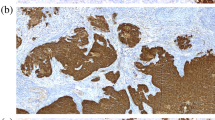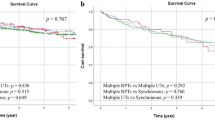Abstract
Tumor budding, defined as a single cancer cell or clusters of fewer than five cancer cells observed at the tumor invasion front, has been reported to be associated with poor prognosis in various types of cancers. However, limited information regarding the pathological and prognostic significance of tumor budding in upper urinary tract urothelial carcinoma (UUTUC) is available. We investigated 135 consecutive patients with newly diagnosed invasive UUTUCs (73 with renal pelvic cancers and 62 with ureteral cancers) treated with nephroureterectomy or partial ureterectomy between 1999 and 2018 in our hospital. Under a × 200 magnification, tumors with 10 or more budding foci were defined as “high tumor budding”. The median follow-up period was 53.6 months. Among the 135 patients, 41 (30%; 16 with renal pelvic cancers and 25 with ureteral cancers) showed high tumor budding. High tumor budding was related to adjuvant chemotherapy status, higher pathological T stage, lymphovascular invasion, lymph node metastasis, tumor location, concomitant variant histology, and non-papillary gross finding. The multivariate Cox analysis revealed that LVI and high tumor budding were independent predictors for extraurothelial recurrence (P = 0.039 and 0.014, hazard ratio = 2.50 and 2.88, respectively), and high tumor budding was an independent predictor for overall survival (P = 0.024, hazard ratio = 2.33). Tumor budding can be easily introduced in clinical practice with no need for immunohistochemical analysis, may be an important clinicopathological factor of UUTUC, and is suggested to be useful as a novel predictive prognostic factor of patients with invasive UUTUC.




Similar content being viewed by others
References
Green DA, Rink M, Xylinas E, Matin SF, Stenzl A, Roupret M, Karakiewicz PI, Scherr DS, Shariat SF (2013) Urothelial carcinoma of the bladder and the upper tract: disparate twins. J Urol 189:1214–1221
Sassa N, Tsuzuki T, Fukatsu A, Majima T, Kimura T, Nishikimi T, Yoshino Y, Hattori R, Gotoh M (2012) Is pT3 urothelial carcinoma of the renal pelvis a homogeneous disease entity? Proposal for a new subcategory of the pT3 classification. Histopathology 61:620–628
Roscigno M, Cha EK, Rink M, Seitz C, Novara G, Chromecki TF, Fritsche HM, Matsumoto K, Walton TJ, Carballido J, Filippo Da Pozzo L, Bertini R, Ficarra V, Otto W, Karakiewicz PI, Pycha A, Fajkovic H, Naspro R, Scherr DS, Montorsi F, Shariat SF (2012) International validation of the prognostic value of subclassification for AJCC stage pT3 upper tract urothelial carcinoma of the renal pelvis. BJU Int 110:674–681
Jimenez RE, Gheiler E, Oskanian P, Tiguert R, Sakr W, Wood DP Jr, Pontes JE, Grignon DJ (2000) Grading the invasive component of urothelial carcinoma of the bladder and its relationship with progression-free survival. Am J Surg Pathol 24:980–987
Skeldon SC, Semotiuk K, Aronson M, Holter S, Gallinger S, Pollett A, Kuk C, van Rhijn B, Bostrom P, Cohen Z, Fleshner NE, Jewett MA, Hanna S, Shariat SF, van der Kwast TH, Evans A, Catto J, Bapat B, Zlotta AR (2013) Patients with Lynch syndrome mismatch repair gene mutations are at higher risk for not only upper tract urothelial cancer but also bladder cancer. Eur Urol 63:379–385
Dawson H, Lugli A (2015) Molecular and pathogenetic aspects of tumor budding in colorectal cancer. Front Med 2:11
Ueno H, Mochizuki H, Hashiguchi Y, Shimazaki H, Aida S, Hase K, Matsukuma S, Kanai T, Kurihara H, Ozawa K, Yoshimura K, Bekku S (2004) Risk factors for an adverse outcome in early invasive colorectal carcinoma. Gastroenterology 127:385–394
Fukumoto K, Kikuchi E, Mikami S, Ogihara K, Matsumoto K, Miyajima A, Oya M (2016) Tumor budding, a novel prognostic indicator for predicting stage progression in T1 bladder cancers. Cancer Sci 107:1338–1344
Kevans D, Wang LM, Sheahan K, Hyland J, O'Donoghue D, Mulcahy H, O'Sullivan J (2011) Epithelial-mesenchymal transition (EMT) protein expression in a cohort of stage II colorectal cancer patients with characterized tumor budding and mismatch repair protein status. Int J Surg Pathol 19:751–760
Zlobec I, Lugli A (2010) Epithelial mesenchymal transition and tumor budding in aggressive colorectal cancer: tumor budding as oncotarget. Oncotarget 1:651–661
Kalluri R, Weinberg RA (2009) The basics of epithelial-mesenchymal transition. J Clin Invest 119:1420–1428
Hase K, Shatney C, Johnson D, Trollope M, Vierra M (1993) Prognostic value of tumor “budding” in patients with colorectal cancer. Dis Colon Rectum 36:627–635
Zlobec I, Hädrich M, Dawson H, Koelzer VH, Borner M, Mallaev M, Schnüriger B, Inderbitzin D, Lugli A (2014) Intratumoural budding (ITB) in preoperative biopsies predicts the presence of lymph node and distant metastasis in colon and rectal patients. Br J Cancer 110:1008–1013
Betge J, Kornprat P, Pollheimer MJ, Lindtner RA, Schlemmer A, Rehak P, Vieth M, Langner C (2012) Tumor budding is an independent predictor of outcome in AJCC/UICC stage II colorectal cancer. Ann Surg Oncol 19:3706–3712
Choi HJ, Park KJ, Shin JS, Roh MS, Kwon HC, Lee HS (2007) Tumor budding as a prognostic marker in stage-III rectal carcinoma. Int J Color Dis 22:863–868
Park KJ, Choi HJ, Roh MS, Kwon HC, Kim C (2005) Intensity of tumor budding and its prognostic implications in invasive colon carcinoma. Dis Colon Rectum 48:1597–1602
Nakadoi K, Oka S, Tanaka S, Hayashi N, Terasaki M, Arihiro K, Shimamoto F, Chayama K (2014) Condition of muscularis mucosae is a risk factor for lymph node metastasis in T1 colorectal carcinoma. Surg Endosc 28:1269–1276
Tateishi Y, Nakanishi Y, Taniguchi H, Shimada T, Umemura S (2010) Pathological prognostic factors predicting lymph node metastasis in submucosal invasive (T1) colorectal carcinoma. Mod Pathol 23:1068–1072
Wang LM, Kevans D, Mulcahy H, O'Sullivan J, Fennelly D, Hyland J, O'Donoghue D, Sheahan K (2009) Tumor budding is a strong and reproducible prognostic marker in T3N0 colorectal cancer. Am J Surg Pathol 33:134–141
Kadota K, Yeh YC, Villena-Vargas J, Cherkassky L, Drill EN, Sima CS, Jones DR, Travis WD, Adusumilli PS (2015) Tumor budding correlates with protumor immune micro environment and is an independent prognostic factor for recurrence of stage I lung adenocarcinoma. Chest 148:711–721
Salhia B, Trippel M, Pfaltz K, Cihoric N, Grogg A, Lädrach C, Zlobec I, Tapia C (2015) High tumor budding stratifies breast cancer with metastatic properties. Breast Cancer Res Treat 150:363–371
O'Connor K, Li-Chang HH, Kalloger SE, Peixoto RD, Webber DL, Owen DA, Driman DK, Kirsch R, Serra S, Scudamore CH, Renouf DJ, Schaeffer DF (2015) Tumor budding is an independent adverse prognostic factor in pancreatic ductal adenocarcinoma. Am J Surg Pathol 39:472–478
Angadi PV, Patil PV, Hallikeri K, Mallapur MD, Hallikerimath S, Kale AD (2015) Tumor budding is an independent prognostic factor for prediction of lymph node metastasis in oral squamous cell carcinoma. Int J Surg Pathol 23:102–110
Küçük Ü, Ekmekçi S, Çakır E, Ekin Z, Ergani B, Ekin GR (2018) Prognostic significance of tumor budding in muscle invasive urothelial carcinomas of the bladder. Turk J Urol 45:273–278
Oken MM, Creech RH, Tormey DC, Horton J, Davis TE, McFadden ET, Carbone PP (1982) Toxicity and response criteria of the Eastern Cooperative Oncology Group. Am J Clin Oncol 5:649–655
Grignon DJ, Lloreta J, Al-Ahmadie H et al (2016) Infiltrating urothelial carcinoma. Urotherial tumours. In: Mock H, Humphrey PA, Ulbright TM, Reuter VE (eds) WHO classification of Tumours of the urinary system and male genital organs. IARC press, Lyon, pp 81–98
McKiernan JM, Hansel DE, Bochner BH et al (2017) Renal pelvis and ureter. In: Amin MB, Edge S, Greene F, Byrd DR, Brookland RK, Washington MK et al (eds) AJCC Cancer staging manual, 8th edn. Springer International Publishing, New York, pp 749–755
Rolim I, Henriques V, Rolim N, Blanca A, Marques RC, Volavšek M, Carvalho I, Montironi R, Cimadamore A, Raspollini MR, Liang C, Lopez-Beltran A (2020) Clinicopathologic analysis of upper urinary tract carcinoma with variant histology. Virchows Arch 477:111–120
Liu J, Cai M, Chen J, Liao Y, Mai S, Li Y, Huang X, Liu Y, Zhang J, Kung H, Zeng Y, Zhou F, Xie D (2014) α4 contributes to bladder urothelial carcinoma cell invasion and/or metastasis via regulation of E-cadherin and is a predictor of outcome in bladder urothelial carcinoma patients. Eur J Cancer 50:840–851
Miyake M, Hori S, Morizawa Y, Tatsumi Y, Toritsuka M, Ohnishi S, Shimada K, Furuya H, Khadka VS, Deng Y, Ohnishi K, Iida K, Gotoh D, Nakai Y, Inoue T, Anai S, Torimoto K, Aoki K, Tanaka N, Konishi N, Fujimoto K (2017) Collagen type IV alpha 1 (COL4A1) and collagen type XIII alpha 1 (COL13A1) produced in cancer cells promote tumor budding at the invasion front in human urothelial carcinoma of the bladder. Oncotarget 8:36099–36114
Yamada N, Sugai T, Eizuka M, Tsuchida K, Sugimoto R, Mue Y, Suzuki M, Osakabe M, Uesugi N, Ishida K, Otsuka K, Matsumoto T (2017) Tumor budding at the invasive front of colorectal cancer may not be associated with the epithelial-mesenchymal transition. Hum Pathol 60:151–159
Acknowledgments
The authors thank Mr. Susumu Tominaga, Ms. Chinami Onuma, and Ms. Ruu Hokari for their excellent technical assistance.
Funding
This work was supported in part by a grant-in-aid for the Promotion of Defense Medicine from the Ministry of Defense, Japan (K.M., H.T.).
Author information
Authors and Affiliations
Contributions
K.K. collected the clinical patient data, examined histopathological findings, performed the experiments, analyzed the data, participated in the study design, and wrote the manuscript. K.M. assisted in clinical data acquisition, histopathological examination, and revised the manuscript. J.A. and K.S. provided the reference pathology for all the samples used, and revised the manuscript. S.M., H.T., and K.I. conceived the study, analyzed the data, and revised the manuscript.
Corresponding author
Ethics declarations
All patients gave informed consent for retention and anonymous analysis of their tissue for research purposes in accordance with the requirements of the ethical committee of the National Defense Medical College (Approval No. 4007).
Conflict of interest
The authors declare that there is no conflict of interest.
Additional information
Publisher’s note
Springer Nature remains neutral with regard to jurisdictional claims in published maps and institutional affiliations.
Rights and permissions
About this article
Cite this article
Kawamura, K., Miyai, K., Asakuma, J. et al. Tumor budding in upper urinary tract urothelial carcinoma: a putative prognostic factor for extraurothelial recurrence and overall survival. Virchows Arch 479, 45–55 (2021). https://doi.org/10.1007/s00428-020-02989-0
Received:
Revised:
Accepted:
Published:
Issue Date:
DOI: https://doi.org/10.1007/s00428-020-02989-0




